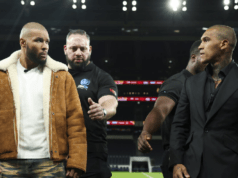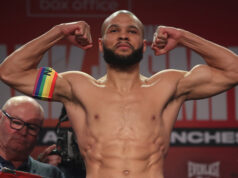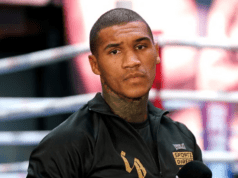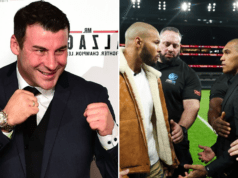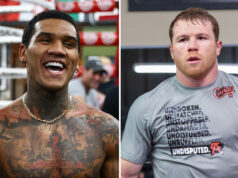By February 1989, Azumah Nelson had risen to become one of the world’s best boxers, earning the moniker “The Professor” along the way. He had gone undefeated as both the WBC’s Featherweight and Super Featherweight Champion, defending those two titles a total of ten times. At age 30, Nelson was no longer the inexperienced stripling Salvador Sanchez had dispatched in 1982.
Meeting again over Sanchez’s IBF Lightweight championship, the two savvy boxers spent the first few rounds feeling each other out, as both remembered the all-out war of 1982 and both wanted to see how much the other guy had improved since then. That momentum spun itself into the exact opposite of what everyone had expected. Instead of an all-action war, a tactical boxing match evolved.
Nelson refused to force the action too hard, as he knew it would only earn him hard counter-lefts. Nelson’s jab and slight edge in reach forced Sanchez to stand as the aggressor rather than use his head movement and counter-punching abilities to maximum effect, and Nelson’s skill resulted in the African landing more accurately on “Chava” than any opponent had yet managed. However, at the end of the day it was Sanchez going forward and landing punches, and that was enough to secure him a Split Decision.
The next target was yet another juicy Mexico vs. Puerto Rico showdown, this time against WBA Lightweight Champion Edwin Rosario. Rosario was a tough Puerto Rican puncher who had held the WBC Lightweight Title, gone 1-1 with Jose Luis Ramirez, outpointed Frankie Randall and Hector Camacho *, knocked out by Sanchez’s bitter rival Julio Cesar Chavez, and won the WBA title in July 1989 by knocking out Anthony Jones in Atlantic City. Sanchez’s team scheduled a non-title defense against a journeyman before an adoring Mexican crowd while waiting for Rosario, leading to a pay-per-view event scheduled for October 1989.
Rumors abounded that the winner of Sanchez vs. Rosario would meet WBC champ Pernell Whitaker and unify the division. The results were anti-climactic. Rosario pulled a “Roberto Duran,” and enjoyed the high life too much and for too long between his bout with Stephens and re-entering training camp. He entered the ring lethargic and drained from the effort of making weight, and later it would come out he still enjoyed the odd coke and booze-fueled visit to the nightclubs even while in camp. By the middle of the 2nd, Sanchez realized how vulnerable his opponent was and plowed forward at full steam.
Rosario landed truly thunderous shots on Sanchez’s chin, but they bounced off just as they did against Chavez, and every bomb gave Sanchez the opening to swarm Rosario with leather. “Chapo” punched himself out by the 5th Round, Sanchez closed in and dropped him twice in the 6th and finished him in the 7th. The 30 year old Sanchez added the black WBA belt to his collection.
Rematch with Sweet Pea
By 1990, Salvador Sanchez had been established as one of the biggest draws in boxing south of heavyweight. While he never earned quite as much money on average as Ray Leonard or Mike Tyson, his biggest pay-per-view fights, such as the rematch with Chavez, were in the same category. Yet at the same time he was 31 and mindful he was reaching the end of his career, and the thing he wanted most was to avenge his defeat at the hands of Pernell Whitaker.
Since they last met, Whitaker had defeated Greg Haugen and Jose Luis Ramirez. The undefeated Sweet Pea was starting to be acknowledged as the great defensive wizard of his generation, and many thought he was the top dog of the lightweight division. Sanchez fought hometown bouts with lesser opponents in Mexico while negotiations over money dragged on, and Whitaker added Juan Nazario’s scalp to his resume in the meantime. Eventually Sanchez gave Whitaker the 50-50 split he insisted upon, since Sanchez had no other big fight option at 135 lbs. The bout to decide the world’s undisputed lightweight championship was scheduled for November 1990.
The opening round brought the legion of Mexicans who traveled to Las Vegas to their feet cheering and shocked the boxing world. Sanchez stormed across the ring, drove a half-cold Whitaker onto the ropes with one straight right and the drilled him with another. Covered up and on the ropes, Whitaker absorbed a patented Sanchez flurry to the body and head, and then bounced off the ropes to clinch the WBA-IBF champion. Sanchez played much harder with Whitaker this time around, using his shoulder and head to rough him up, and then caught the still wobbled WBC champ with a clubbing right that sent him to the canvas. Incredibly, the referee stepped in declaring “no knockdown, no knockdown!” and ruled that Whitaker had been pushed rather than punched. Both Sanchez and his corner exploded with outrage, eating up precious time. Whitaker survived the round and returned to his corner.
Whitaker boxed cautiously for the 2nd Round, blocking more than moving or slipping as his legs came back. By the 4th, Whitaker was working his magic, but the next few rounds were very close indeed. By the second half of the fight, Whitaker had adjusted to Sanchez’s efforts to rough-house and brawl, re-establishing the tools that edged the Mexican legend in the first bout, sweeping Rounds 7 through 9 on all the scorecards. Then Sanchez came out in the 10th and turned up the pressure to all-new heights.
It was hard to pick a single second in Round 10 when Sanchez did not have his hands in motion, all in a bid to overwhelm Whitaker’s defense – and it worked! In Round 10, Sanchez set the world record for the most punches thrown ** in a single round with 242 blows, and threw 231 in Round 11. Even as he threw more punches, his connect rate climbed from the teens to almost 25%. Whitaker wilted under the storm of leather.
But then the thing that had never happened before occurred. Sanchez, a fighter who cut his teeth on 15-Round wars of attrition, ran out of gas. Whitaker was still on his feet, and sensing his chance to bank the final stanza, tore at Sanchez with everything he had. Sanchez was unhurt, but he dropped the 12th.
Once again, the crowd was tense and quiet waiting for the scorecards. Whitaker was demonstrably pensive, but breathed a sigh of relief when Michael Buffer read “For Pernell Whitaker, 115-114.” The next card gave Sanchez a 114-113. And then the third card made the fight one of the most controversial of the 1990s: 114-114. The fight was declared a Draw, yet everyone knew if the knockdown in the 1st Round had been scored correctly, the scores would have been 114-114, 114-112 and 114-113 — a narrow Split Decision for Sanchez. Whitaker had escaped his first loss by the narrowest of margins, while Sanchez wound up with his very first Draw.
* A good counterfactual story always takes into account the “ripple effect.” In real life, Hector Camacho lost any trace of his macho demeanor after his encounter with Edwin Rosario. In my storyline, that happened much earlier when he fought Sanchez in Part 1. The result was that Camacho, without his prior record and fighting from a safety-first posture from the very beginning of his counterfactual meeting with Rosario, dropped a Split Decision points loss. Ironically, the huge victory over Camacho accelerated Rosario’s partying and slide into substance abuse.
** The real record is held by Vince Phillips, who threw an amazing 237 punches in the 12th Round against Ray Oliveira.


